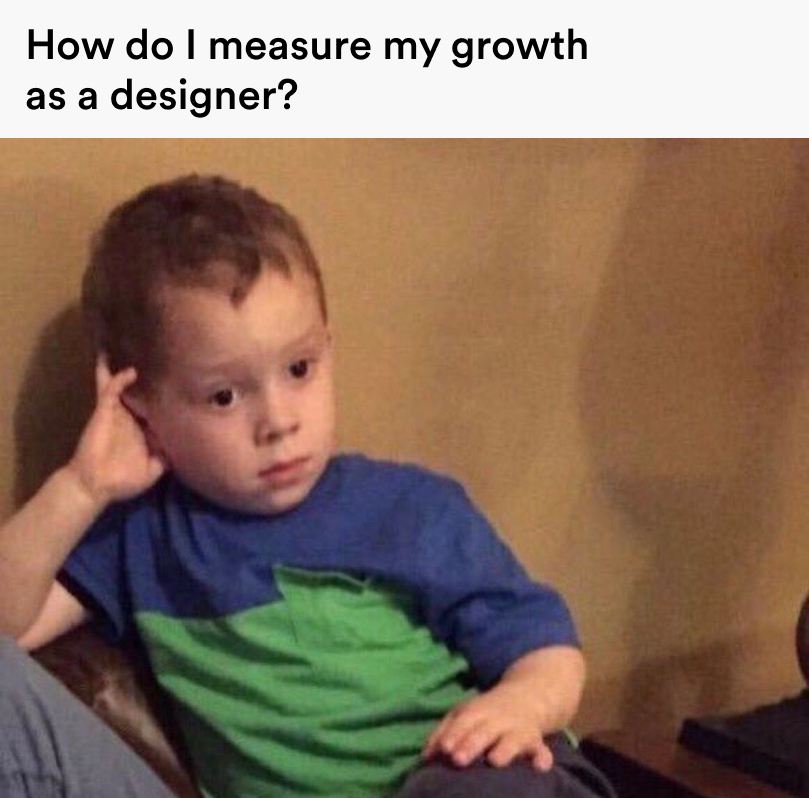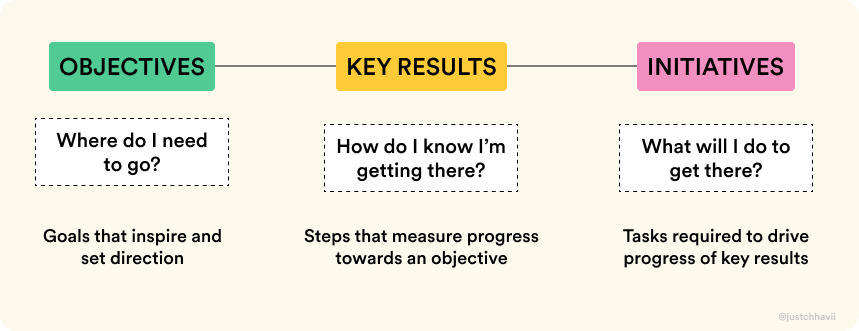

How to measure your growth as a designer?
source link: https://blog.prototypr.io/how-to-measure-your-growth-as-a-designer-e19b3fa234ea
Go to the source link to view the article. You can view the picture content, updated content and better typesetting reading experience. If the link is broken, please click the button below to view the snapshot at that time.
How to measure your growth as a designer?
Practical tips and examples to set and use OKRs as a designer.
We don’t have JIRA tickets or story points to calculate our efficiency, and surely counting number of screens we churned will just give us a number. A lot of our time is spent honing our soft skills, and keeping up with design twitter. There is tons of blogs on how to measure the impact of design in a company. But how do you personally measure your growth as a designer? 🤔

Enter OK-errs
Not the only way, but one way could be setting up some OKRs for your career as a designer.
Objective key results (aka OKRs) is a framework to set collaborative and measurable goals. Collaborative — so that means goals are interlinked with your company and team goals. Measurable means you can measure them and get some validation from it.💁♀️

OKRs do get a bad reputation because…
I expect to hear some hesitation and dismissals.
- OKRs can be time-consuming to set up.
- Work best if they are set at every level (i.e company > team > individual)
- Let’s be honest — a lot of documents just end up being documents.
Be it just how fast the company moves, or how much documentation it creates, OKRs docs can often end up being redundant.
Reasons why designers don’t tend to like OKRs 🙃
Even if your company or product team do follow OKRs, some designers tend to run away from it…
- Design is so subjective. How could I possibly measure it in numbers? Do I like measure the number of screens I create?
- My company OKRs are a lot of numbers and percentages, I don’t understand half of them. Even if I do, I don’t know how my designs contribute to them.
- I don’t get how OKRs could help my career personally.
- It is time-consuming to write. I am not that good at writing. No one is going to read them.
All or some or none of the above can be true for you. But I would still nudge you to give it a shot.
…but here’s how OKRs can help designers.
- First and foremost, with some tweaks and tries, OKRs can be an effective framework to track your personal growth and motivate yourself. This has nothing to do with you being a designer or not.
It’s a bonus, if your company and team also uses OKRs, makes your professional life easier. - Don’t worry much about your design creates buisness impact. It is a battle being fought by many valiant design and product leaders. You don’t have to worry about it all alone. You can set up numbers that make sense for your growth.
- By using a framework and clearer goals, you are helping others to help you. Be it your managers, or colleagues, if you know what you want to achieve, they can help you more.
- If you are working in a company of more than 10 people, you need a way to track and communicate your impact and progress. Having OKRs could be one way to do that.
- Change of managers/teams/roadmap are all part of our jobs. Having a. holistic set of OKRs can help you stay focused on your goals.
So how do I go about setting my OKRs?
Personally, I feel your objectives should cover broadly these 3 areas —
🧳 Business impact
- communicating value of design, processes and documentation, innovation, etc.
🌸 Team initiatives
- improving the design quality, hiring, advocacy, culture, etc
🖍 Upskilling
- design and leadership skills, product knowledge,
Some example of key results
🧳 Lead designs for at least 3 projects targeted at improving user retention
🧳 Competitive analysis of 4 apps and suggest new features for the roadmap
🧳 Propose/evolve at least 2 collaboration processes b/w design, content, product, and engineering
🌸 Help at least two pod members on best practices to use auto-layout
🌸 Host at least 2 workshops on design thinking
🖍 Complete at least 2 Advanced courses on Figma/Prototyping tool
🖍 Host/present in at least 2 team-wide meetings
Try and put numbers next to key results as much as possible, easier to measure.
So overall your OKRs doc could look like —

How to make the best out of your OKRs?
One of the biggest risks of setting OKRs is that it ends up being just another document that you don’t refer back to.
Some ways to make the best out of it —
• Share it widely with your team, manager, and their manager.
• Add a column to track your progress. You can even color-code it.
• In your self-evaluation, and performance reviews, use your OKRs to talk about your impact.
• Set up a monthly call with your managers to talk about it.
• Add a link/bookmark, somewhere easily accessible, so that you are tempted to see it.
• Have the right mix of OKRs — not every goal needs to be that of a 10x designer lol. Add goals that motivate you. That support where you wanna head personally.
My personal tip would be not spend more than a hour setting your OKRs up, and then tweaking and adopting them as you go along.
I think you gotta try out a bunch of things — simplify ruthlessly to make it something that is doable and sustainable for you. Finding ways to measure your growth is no different. I hope you find your way.
Chhavi xx
Some other ways and systems that work for me 👀

Recommend
About Joyk
Aggregate valuable and interesting links.
Joyk means Joy of geeK